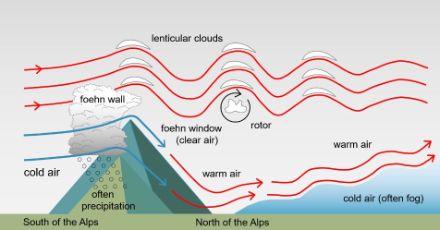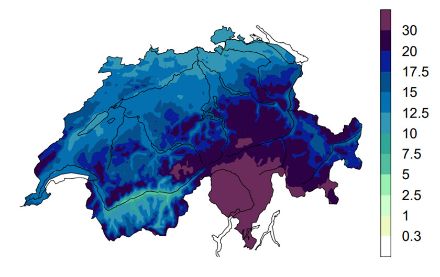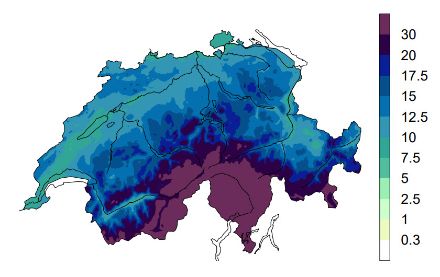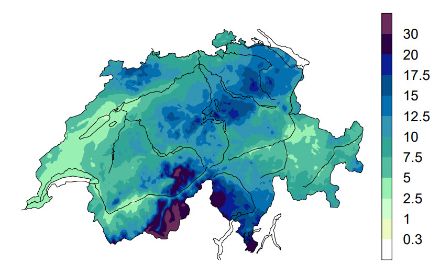Service Navigation
Search
The prerequisite for a southern orographic effect is a dynamic situation with a south-westerly to south-easterly upper air flow, which is almost perpendicular to the Alpine arc and brings a lot of moisture to the Alps.
The orographic effect on the southern slopes of the Alps leads to heavy cloud cover and precipitation on the southern side of the Alps.
The most active orographic effects in the south, with the most precipitation, are associated with a low pressure area to the west of Switzerland, which brings mild and very humid air from the Mediterranean in a south-westerly to south-easterly flow. When the air arrives at the Alps in a vertical direction, it is forced to rise. This upward movement expands and cools the air, causing the water vapour in the air to condense. The resulting clouds produce considerable precipitation on the exposed slopes. The longer the moisture flow lasts, the more precipitation can fall on the southern slopes of the Alps. Except in winter, southern orographic effects are often accompanied by widespread thunderstorms, which then produce particularly heavy rainfall.
On the north side of the Alps the air sinks and dries out, creating a foehn flow. The northern side of the Alps will therefore remain mostly dry and slightly cloudy in this situation. However, depending on the position of the low, significant precipitation may also spread north of the Alps.

The amount of precipitation varies according to the direction of the flow at altitude. One can distinguish between three different orographic effects: South-westerly orographic effect, southerly orographic effect and south-easterly orographic effect
Orographic effect due to south-westerly inflow
Mild and humid air is carried from the Atlantic to the Alps when the flow is from the south-west. Depending on the synoptic situation, the flow can also be supplied with moisture from the Mediterranean. The whole of Switzerland can be affected by precipitation with a south-westerly flow, but the highest amounts occur in Ticino, Misox, Bergell and Val Poschiavo. Heavy precipitation may also spread to parts of the central and eastern Alps.

Orographic effect due to southerly inflow
When the flow is from the south, very humid air is transported from the Mediterranean to the Alps. Precipitation can affect the whole country in certain situations, but the heaviest amounts are recorded in Ticino and Misox. Precipitation extends beyond the southern ridge of the Alps, especially in the Upper Valais, which is also one of the most affected regions.

Orographic effect due to south-easterly inflow
With a south-easterly flow, the air transported to the Alps is less humid than with south-westerly and southerly flows. In this situation, precipitation falls mainly in part of the Upper Valais (Simplon region and Saas Valley). The extreme south of Ticino and the Maggia Valley are also the areas most affected by precipitation in this situation.
